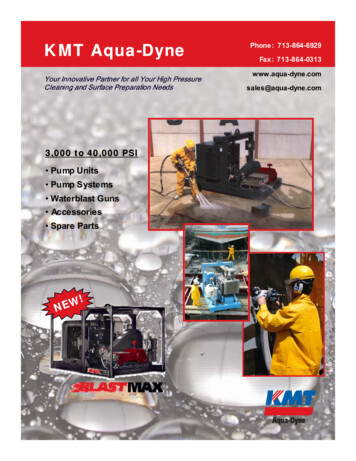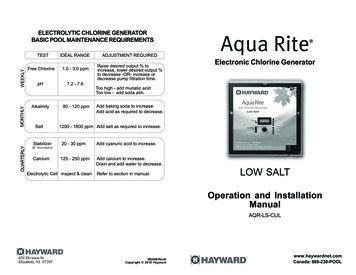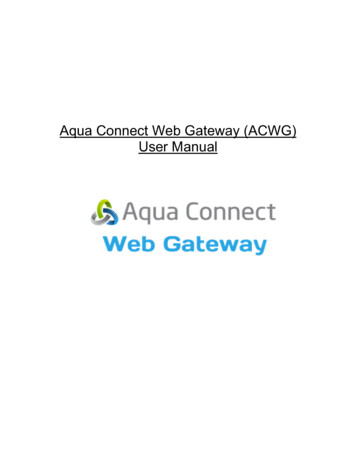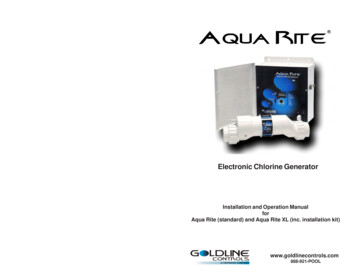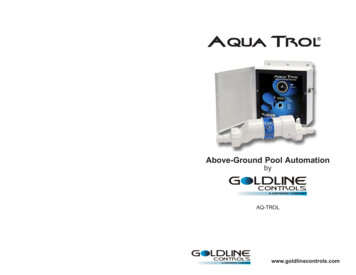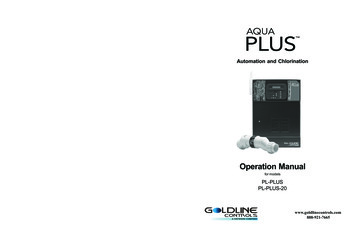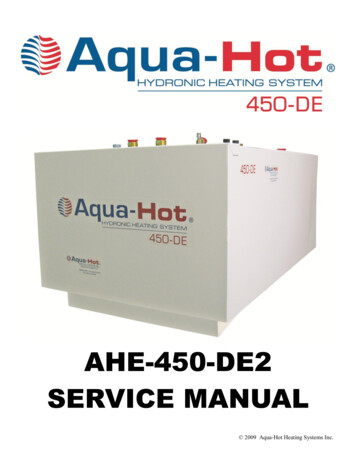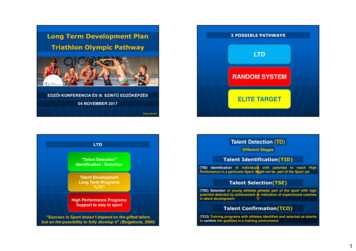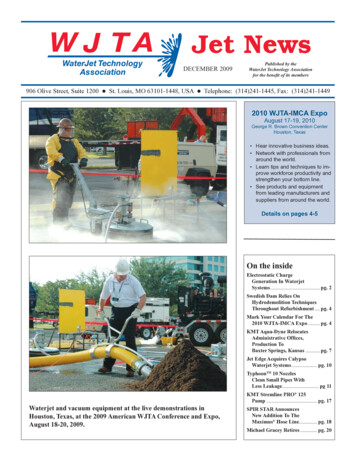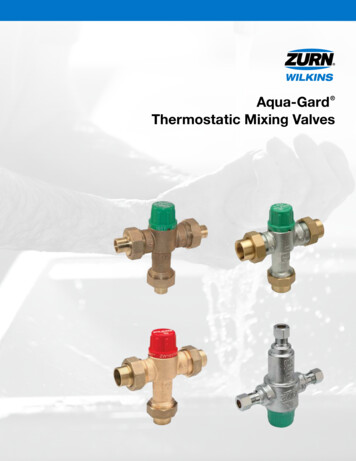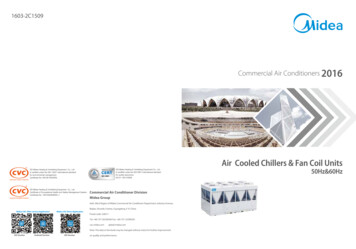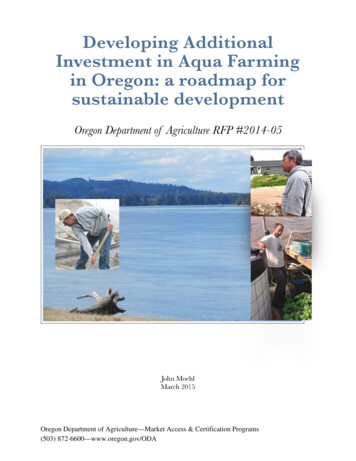
Transcription
Developing AdditionalInvestment in Aqua Farmingin Oregon: a roadmap forsustainable developmentOregon Department of Agriculture RFP #2014-05John MoehlMarch 2015Oregon Department of Agriculture—Market Access & Certification Programs(503) 872-6600—www.oregon.gov/ODA
AcknowledgementsThe author1 wishes to express appreciation for the support offered by all engagedin this activity; those who have contributed knowledge and those who have contributedimagination. Aqua farming in Oregon has been a lonely undertaking engaging only ahandful of pioneers, often unable to blaze permanent trails through entangled pathways.The contributors to the present work have shown with their enthusiasm that it isnow the right time to build on these pioneering efforts and develop a well articulated program that can meet expectations of all.Special recognition is made for those who have generously provided funds for thisactivity: the USDA-Rural Business Enterprise Grant, the Oregon Department of Agriculture, the Coquille Economic Development Corporation, Pacific Seafood and the OregonAquaculture Association. Particular acknowledgment is also paid to those who have devoted large blocks of time assisting with the activity, representing the wide spectrum ofaqua-farming-related staff from: USDA and the Oregon Departments of Agriculture,Fish and Wildlife, State Lands, Water Resources, Environmental Quality and Land Conservation and Development; Oregon State University Hatfield Marine Science Centeralong with Chemeketa and Oregon Coast Community Colleges; the Oregon Shellfish andInland Aquaculture Advisory Group; Oregon Oyster Farms, Whisky Creek ShellfishHatchery, Santiam Valley Ranch, the Farming Fish, Desert Springs Trout Farm, PrairieSprings Fish Farm, Oregon Aqua Farms, Blue Den Ranch; and, the Ports of Alsea andCoos Bay.John Moehl, PhD., Aquaculture Specialist, Realised Expectations/AFFIRM, 330 NW Valley View Ct,McMinnville OR 97128 (USA) — planil03@gmail.com1INVESTING IN OREGON AQUA FARMINGODA RFP #2014-05 — PAGE "2
INVESTING IN OREGON AQUA FARMINGODA RFP #2014-05 — PAGE "3
Executive SummaryThe work encapsulated in the present report represents an effort to examine howmore investment could be made in the Oregon Aqua Farming Program to significantlyincrease this program’s impact on the State’s economy and the livelihoods of its citizens.The program was analyzed in terms of its current activities and future possibilities. Thisanalysis included summarizing issues affecting the growth of the program as well as offering options for how this growth might be accelerated. These analyses reviewed the institutional setting of the program, incorporating processes and compliances necessary for investors to undertake aqua farming.The report has a comprehensive set of twenty conclusions and recommendationswhich have been integrated into the five key takeaway points below:1. Aqua farming is in consonance with the Oregon Way, a significantly larger program possible through expansion, intensificationand diversification. A target value of 22.8M is proposed for astrengthened statewide program (current value of 12.1M). Toachieve this, the state must optimize her natural endowments.2. There are more commonalities than differences among core issues affecting aquatic crop production statewide, regardless ofthe ecosystem — issues for which practical and responsible solutions exist.3. Misinformation leads to exaggerated fear of unfounded dangersprovoked by aqua farming as well as to poor investments founded on unrealistic and ill-founded hopes.4. Collaborative action is needed with a centralized coordinatingunit [ODA] serving as the focal point with the private sectorplaying an active role. Together these partners need to developtools to increase responsible investment.5. To guide this evolution, a state aqua farming plan is needed to, among others, target education, research and extension/outreach services — this requiring additional human and financial resources.The State’s shellfish industry is monolithic, oysters the only crop, and the driver ofthe state program. Inland aquaculture as a producer of food for the table is a nascent enterprise in the State which has yet to achieve any critical mass whereby operators can influence policies or processes.Over recent months momentum has been achieved with important milestones suchas establishing the Oregon Shellfish and Inland Aquaculture Advisory Group (OSIAAG) to identifyways and means to amplify the State’s aqua farming program. Concurrently, the globalmarket for aquatic products is growing as are technologies to responsibly and profitablyfarm a wide variety of marine and inland waters. Given this convergence of market op-INVESTING IN OREGON AQUA FARMINGODA RFP #2014-05 — PAGE "4
portunity and access to innovative technologies, the Oregon program is at an importantjuncture. The stage is set for existing farmers to increase their production while newcomers enter the program producing a wide array of aquatic products. However, for this economic growth to happen, there must be immediate political and financial support. Specific aquaculture-flagged funding is necessary in 2015 if these opportunities are not to belost. This funding can be from regular state fiscal resources, be extra-budgetary or a combination of the two. It is urgently needed.OSIAAG needs to be the lens through which a new program is viewed and thefilter through which this program is formed. Careful assessment and planning, throughOSIAAG, is critical before any major new regulations are introduced: there are simply toomany outstanding questions at this time to know how best any new regulation/legislationshould be formulated or how existing regulations should be modified or adjusted. Fromthe present work, it can be concluded that, while existing rules and regulations are notoverly oppressive; many serving well understood and appreciated functions, but othersrequiring major updating.Thus, funds should be used to design and implement a short-term Support to OregonAqua Farmers that will, in collaboration with OSIAAG: (i) undertake a comprehensive review of the status quo [building on the present document]; (ii) actively promote investmentin aqua farming; (iii) elaborate a state aqua farming plan (Plan for Sustainable andResponsible Aqua Farming Development in Oregon); and, (iv) identify legislationrequired for the implementation of this Plan.INVESTING IN OREGON AQUA FARMINGODA RFP #2014-05 — PAGE "5
Table of ContentsAcknowledgementsExecutive SummaryList of AcronymsIntroductionPreamble1. Situation AnalysisGuiding PrinciplesStatus QuoPerceptionsEnvironmental & Social DimensionsOptions (marine and in-land)ExpansionSynopsis2. ProcessesAuthorization & RegulationInstitutional ArrangementsNew & Evolving PathwaysRoles for the Public & Private SectorsKey IssuesThe Oregon WaySynopsis3. Road MapWay Forward: Opportunities & ConstraintsConclusions & RecommendationsNext StepsPost Script: THE Plan4. ANNEXESAnnex I Flowcharts: processes and proceduresAnnex II: Map of ODA shellfish programAnnex III: Shellfish IndustryAnnex IV: Case studiesAnnex V: ODA OrganogramINVESTING IN OREGON AQUA 84344464652535557ODA RFP #2014-05 — PAGE "6
List of AcronymsAIS — Aquatic Invasive SpeciesARS — Agricultural Research Service of USDAASC — Aquaculture Stewardship CouncilBPA — Bonneville Power AdministrationCITES — Convention on International Trade in Endangered SpeciesDEQ — Oregon Department of Environmental QualityDSL — Oregon Department of State LandsEEZ — Exclusive economic zoneEPA — US Environmental Protection AgencyESA — Endangered Species ActESH — Essential salmon habitatFAO — Food and Agriculture Organization of the United NationsFCR — Feed conversion ratioFDA — US Food and Drug AdministrationFERC — Federal Energy Regulatory CommissionFIC — Food Innovation CenterFSA — USDA’s Farm Service AgencyFSP — ODA’s Food Safety ProgramFWS — US Fish and Wildlife ServiceHACCP — Hazard analysis and critical control points [ systematic preventive approach to food safety]HMSC — Hatfield Marine Science Center [Newport, OR]LUCS — Land use compatibility statementNAA — National Aquaculture AssociationNIFA — USDA’s National Institute of Food and AgricultureNMFS — National Marine Fisheries ServiceNPDES — National Pollutant Discharge Elimination SystemNOAA — National Oceanic and Atmospheric AdministrationNWP — Nationwide permitMCS — Monitoring, Control & Surveillance — typically applied to capture fisheries but applicable to aquacultureOAA — Oregon Aquaculture AssociationOSIAAG — Oregon Shellfish and Inland Aquaculture Advisory GroupODA — Oregon Department of AgricultureODF&W — Oregon Department of Fish and WildlifeODLCD — Oregon Department of Land Conservation and DevelopmentOSU — Oregon State UniversityPCN — Pre-Construction Notification — USAEC requirement for new permitsPCSGA — Pacific Coast Shellfish Growers’ AssociationR&D — Research and DevelopmentSBA — Small Business AdministrationSCS — Soil Conservation ServiceSHPO — State Historic Preservation OfficeUSACE — United States Army Corps of EngineersUSDA — United States Department of AgricultureUSFWS — United States Fish and Wildlife ServiceWRD — Water Resources Department of OregonWRI — World Resources InstituteWWF — World Wildlife FundINVESTING IN OREGON AQUA FARMINGODA RFP #2014-05 — PAGE "7
Often the difference between a successful person and a failure is not one hasbetter abilities or ideas, but the courage that one has to bet on one’s ideas,to take a calculated risk – and to act. – Andre Malraux! (French author, 19011976)INVESTING IN OREGON AQUA FARMINGODA RFP #2014-05 — PAGE "8
Developing Additional Investment inAqua Farming in Oregon: a roadmap forsustainable developmentIntroductionThere is little investment in aqua farming in Oregon. Although aquaculture ispredicted to be the supplier of two-thirds of the aquatic food products consumed worldwide by 20302, this subset of food producing activities is not presently an important industry in the State. With the exception of oyster farming, which has been practiced forgenerations in the State’s estuaries, the husbandry of aquatic organisms has been spottyand basically insignificant.It is difficult to justify this benign neglect in any precise terms as, in most instances,it seems as though the aqua farming sub-sector was simply ignored in spite of regional,national and global trends3. This may, in part, be due to the traditional abundance ofaquatic foods available to the fisher and gatherer; to this day Oregon’s coast offering acornucopia of foods to the exploring consumer.When the wild marine harvest is added to the State’s bounty of freshwaters, seenas being filled with salmon and trout, there may seem to be little impetus to invest ingrowing what occurs naturally.However, aqua farming as an industry is more than a way to put food on the family’s plate. The industry creates jobs, makes productive use of un- and under-used resources, generates high-value export crops while operating at high levels of biological andenergy efficiency.This is not to paint a perfect picture of aquatic farming. As with other forms ofagricultural production, there has been abuse and even best practices are challenged byrapidly changing technologies and norms.Nevertheless, in spite of noteworthy growing pains in the 1980s and 90s [demonstrating the newness of this industry], there has been considerable global effort invested indefining methodologies for responsible and sustainable water farming to the extent thattoday the negative footprint left by the industry is shrinking while the production ofhealthy and environmentally friendly aquatic foodstuffs is expanding around the world.Globally, aquaculture has emerged from the shadows of the hobbyist and the isolated grower to an industry which is one of the fastest growing in many economies, as wellas being one of the most transparent.However, Oregon remains largely on the sidelines.But, those who hesitate now loose market share. Many Oregon-consumed aquaticproducts that could be grown in-state are imported from other states or internationally. Itis time for all to take a look at aquaculture and decide how Oregonians might take /WDSContentServer/WDSP/IB/2014/01/31/000461832 0Fish0to02030.pdf3 It is estimated global aquaculture production will continue to increase, by 2022 the world crop being 85Mtons, a 35% increase over today’s harvest (http://www.fao.org/3/a-i3822e.pdf ?utm content buffer55610&utm medium social&utm source linkedin.com&utm campaign buffer)2INVESTING IN OREGON AQUA FARMINGODA RFP #2014-05 — PAGE "9
tage of the dynamic developments in this increasingly important agriculture sub-sector.PreambleThis document discusses issues relating to getting Oregon off the sidelines, increasing investment in the State’s aqua farming program. It is organized into three mainsections roughly corresponding to the present, past and future — the past and present influencing future investment. The first section describes the industry as it exists today. Itthen examines how this industry is viewed by the public, including its impacts on societyand the environment. The section concludes by looking into some possible new crops forOregon growers as well as putting forth proposals as to how the industry could grow.The second section characterizes the institutional environment which oversees investments in the State’s aqua farming program. It highlights the state, national and localagencies that engage aqua farmers, describing new pathways as well as proposing roles forthe public and private sectors.The final section summarizes the opportunities and constraints and within these,proposes a way forward to enhance investment the State’s program.1.Situation AnalysisThis section looks at aqua farms in Oregon today. How many are there and what do they raise? Itattempts to answer the question of how these farms are viewed by the public as well as summarizing majorsocial and environmental impacts from aqua farming. Within this overall situation, the section concludesby offering options for what could be done differently from a farming perspective; speculating on how thesechanges could affect the scope of the State’s aqua farming program.Guiding PrinciplesThe aqua farming situation is analyzed within the context of several basic assumptions; guiding principles.Before moving to these, it is worthwhile to define aquaculture. It is generally considered that aquaculture is the husbandry of aquatic organisms and that aquaculture isagriculture. To the farmer, this husbandry has elements of raising both plant crops andlivestock; waters can be fertilized as terrestrial fields, animals are bred and seed is supplied.The critical determinant when deciding whether or not an activity is aquaculturalis the degree of control exercised. If the operator controls the aquatic environment and/or the organisms, it is considered as aqua farming.Most often, the comparisons drawn for aquaculture are with “fisheries”; aquaculture, indeed, frequently being categorized as a component of the fisheries sector. Yet, fishers engage in fishing and fishing is akin to hunting. Others who may also call themselvesfishers are more correctly engaged in gathering wild stocks. Those in the fisheries arenaare hunter-gathers. Those in the aquaculture theater are husbandryists, even if they areraising crops caught in the wild.The novelty of aquaculture accompanied at times by reputed paradoxes, can, andhas led to periodic ambiguity as to how the sub-sector is seen and managed. Administratively, operating at the water-land interface can lead to confusion; stakeholders in smallprograms often operating in areas of grey. These cloudy guidelines can block planninghorizons, only vanishing if and when aquaculture solidifies into mainstream agriculture.INVESTING IN OREGON AQUA FARMINGODA RFP #2014-05 — PAGE "10
critical massDecision making is about prioritization; there is a large array of investment options, a wide number of topics which may or may not receive political support. For mostpublic agencies, prioritization is greatly influenced by impact; social, environmental, political and economic impact. Significant numbers of stakeholders and/or high productivitytend to push activities up the priority ladder.Just as there is a minimum financial size for a firm, below which it is not profitable,there is a minimum size for a program; operating below this level making it difficult tojustify the prerequisite public and private services required to support the program. Thisneeded size is the program’s critical mass; the amount of production it must achieve, thenumber of stakeholders it must incorporate, the level of political capital it can generate.It can be very difficult to precisely estimate critical mass. However, its numericvalue is less important than its recognition as a guiding principle; programs not able toachieve critical mass being in jeopardy of disappearing from the economic and politicallandscapes — perhaps justifiably so.market-drivenIn the case of productive enterprises such as aqua farming, economic efficiency isthe pivotal factor. While a program needs to be market-driven, flexible and inclusive, acore of market- and profit-driven operations must reach the accepted critical mass for theprogram to be justifiable; the needed public and private investments offset by the derivedproductivity (e.g., harvest value, employment creation).The market is the driver. NOAA reports: “The United States imports up to 90 percent ofits seafood, about half of which is from aquaculture. This results in a large and growing annual seafoodtrade deficit of more than 10.4 billion.” ( http://www.fishwatch.gov/farmed seafood/outside the us.htm). Although per-capita fish consumption fell from 2010 to 2011 by 0.8%Figure 1: Demands for fishery products relative to foreseen supply from aquaculture and fisheries (in http://www.dfo-mpo.gc.ca/Library/272059.pdf). Additional analysis available from ons/oc44.pdf.INVESTING IN OREGON AQUA FARMINGODA RFP #2014-05 — PAGE "11
(from 15.8 to 14.9 pounds, atistics/allstatistics), as seen in Figure1, globally demand is predicted to rise for the foreseeable future.Over the coming two decades, it is suggested that among protein products, seafood willbe the fastest growing; growing faster than beef or poultry df and /WA2005/WA2005-780.pdf). Within the seafood menu, three of the top four products are importantaqua crops, encouraging he consumption of farm-raised products nationwide (http://seafoodhealthfacts.org/seafood choices/overview.php).Status QuoInvestment in aqua farming in Oregon is low. As stated at the onset, investment isprincipally focused on growing oysters. While 17 of the reported 37 aqua farms in theState raise oysters, the more than 10 million value of this crop gives it an almost sevenfold advantage over its nearest aquatic competitor, trout food fish. The state program ismore fully described by the four figures below, based on the most recent statistics for Oregon aqua crops as per the USDA 2013 Census of Aquaculture (June 2014).MolluscFW Sport FishFW Food FishOrnamenetal FishesFigure 2: Relative number of aqua farms inOregon with different aquatic crops (USDA, 2014)FW freshwaterMarineFreshwaterFigure 4: Relative area (acres) of aquafarms in Oregon in marine and freshwaterenvironments(USDA, 2014)INVESTING IN OREGON AQUA FARMINGMolluscFW Sport FishFW Food FishOrnamental FishesFigure 3: Relative value ( 000) of different aquatic crops (USDA, 2014)OystersCatfishTroutSalmonTilapiaFigure 5: Relative number of farmsgrowing different aquatic crops (USDA,2014)ODA RFP #2014-05 — PAGE "12
From the above, it is clear the marine zone is more active in aqua farming thanfreshwater areas. This fact notwithstanding, in addition to a 363-mile coastline with 22major estuaries, it is estimated there are 1,400 named lakes, 1,300 large mainstreamreservoirs, 10,000 small dams and 111,610 stream miles including the 309-mileWillamette River [State of Oregon Water Resource Department, 2007].In spite of these resources, according to the USDA data for the period 2005 to2013, the overall state program shrank by 20% in terms of number of farms and 3% interms of total cash value. While farm number declined, farm size increased with a 46%and 83% increase in the area cultivated in the marine and freshwater environments, respectively; this change, as seen elsewhere, likely indicating an increase in the economicsize of farms.It may put these data in clearer perspective to note the 2014 Census specifies ninetrout farms sold a total of 245,000 food fish (192 tons). A trout processing plant in Idaho(Idaho Trout Company) processes 15 tons/day — the entire Oregon harvest able to beprocessed in 13 days.However, it should be emphasized the above figures do not tell the whole story.The Oregon Department of Fisheries and Wildlife (ODF&W) operates 32 state aquaculture facilities: salmonid hatcheries. In the aggregate, these units produce over 40 millionsalmon, steelhead and trout annually that account for 70% of the sport and commercialfish harvests and have an estimated total economic value of 904 million (Oregon Fish &Wildlife: Inland Fisheries — Hatchery Management, January 22,2013).PerceptionsAqua farming is viewed through many lenses. It is worth remembering that aquaculture as a food producing sub-sector is a relatively recent innovation. Although aquaticfarming in others parts of the world has a much longer tradition, in the United Statesaquaculture only dates to the mid-1800s, focusing principally on sport fisheries, mainlysalmonids, until the early 1960s. Parker provides a more detailed history ments/HistoryofAquaculture.pdf). The newnessof farming waters in the US has contributed to a scenario where technologies changerapidly4; at times, perceptions having a hard time to keep up.Proponents note the opportunities from rapidly growing demand for aquaticproducts due to accelerating population growth vis-à-vis declining supply from wild stocksthat favors aqua farming. Aqua farming as a set of growth industries continues to havesuccesses. NOAA has documented successes in California, Hawaii and Washington(http://www.nmfs.noaa.gov/sfa/reg 07TrainingCD/TabY-Aquaculture/02 AquacultureSuccessStories June%202007.pdf). To cite afew, other successes are documented for Idaho d 14), Florida tories/397-floridaorganic-aquaculture),Virginia ), West Virginia pdf) and Canada .php).However, all is not rosy. Opponents caution that aquaculture, like agriculture, engages in harmful [to the consumer and/or the environment] practices that are all themore worrisome as they directly affect essential waters. Ken Stien’s article in Time (“Fish4Current discussions on aqua farming technologies can be found on Twitter at #aquacultureINVESTING IN OREGON AQUA FARMINGODA RFP #2014-05 — PAGE "13
Farming’s Growing Dangers”, September 19,2007) summarizes well thecore concerns:“Unless the [aquaculture] industry finds alternatives to using pelagic fish to sustain fish farms theaquaculture industry could end up depleting anessential food source for many other species in themarine food chain There are other collateralproblems created by industrial scale aquaculture: thedestruction of coastal habitats through waste disposal, the introduction of diseases and the possibleescape of exotic species that can threaten indigenousbreeds.”As highlighted by Stien, thereare real technical issues inherent in raising aquatic organisms which could provoke concerns. Nonetheless, again perhaps exacerbated by the sub-sector’snewness, there is a considerable knowledge gap among the general public. It isfrequently difficult for the observer tothoroughly grasp the interrelationshipsto know if an issue is, or is not a problem. When faced with uncertainty, thefall-back is to err on the side of conservation.Accordingly, public perceptionsof aqua farming often see the introduction of a new underwater form offarming as too risky. An example of aless measured perception is the following emphatic statement:“Fish farms, or “aquafarms,” discharge waste,pesticides, and other chemicals directly into ecologically fragile coastal waters, destroying local ecosystems. And aquaculture farms that raise fish directlyin fenced-in areas of natural waters kill off thriving natural habitats by overloading them far beyondtheir capacity. Waste from the excessive number offish can cause huge blankets of green slime on thewater’s surface, depleting oxygen and killing muchof the life in the water.” -badfor-the-environment/)Unbalanced or overgeneralizingreporting often dominates the information which is available to the observer.As another example of strong opposition focusing on off-shore culture:THE INDIANA MODEL: thestate of Indiana is slightly south of Oregon (i.e.,37-41º latitude vis-à-vis 42-46º]. However, it hasgreater temperature fluctuations: 16-89º F for Indiana and 33-83º F for Oregon ( http://www.netstate.com/state geography.htm). At one time aquaculturewas not part of the Indiana economy ( 271463/ ). Todayaquaculture thrives. A 2003 study, Economic Importance of Aquaculture Industry in Indiana, concluded:“While aquaculture is not the most well-known industry in Indiana’s agriculture sector, it is definitelypresent and very important to the state’s economy.The industry has seen steady growth over the past fewyears, and it is important to know exactly how mucheconomic activity is associated with aquaculture inIndiana.Because of the money generated within the state,people being employed, and taxes generated for thestate, the Indiana economy benefits from the aquaculture industry. There are 280 citizens of Indianawho have jobs that are supported by this industry,and 37,892,895 worth of output is generatedthrough the local economy because of this industry.Employees in the state are paid 7,541,867 annuallyin the aquaculture industry and other industries supported by aquaculture. The aquaculture industry generates 19,484,193 worth of total value added to thestate’s GDP annually. These are jobs and revenue thatcould possibly disappear if the aquaculture industrywere non-existent in Indiana. These results show theimportance of the industry to Indiana’s economy,which will enable industry professionals and thoseinterested in aquaculture to better justify investmentsinto further research and development of the aquaculture industry. This is important for the futuregrowth and sustainability of the industry as it continues to expand and keep up with aquaculture in therest of the country and the world.” ASarticle.pdfOffshore fish farming, also known as open ocean aquaculture, involves giant cages located about 30 feet under wateranywhere from three to 200 miles off the coast. Here are 10 reasons why this is so problematic: Competing/Conflicting Interests, open water aquaculture facilities could cause conflict of interest — areas of currentsignificant competing economic use or public value must be eliminated for consideration for open ocean aquaculture;INVESTING IN OREGON AQUA FARMINGODA RFP #2014-05 — PAGE "14
Escapement, offshore aquaculture of finfish uses cages or pens — these containers, even if well engineered andbuilt, will allow some fish escapes into the open ocean; Growing Exotic / Mutated Species, several problemsare associated with aquaculture production of non-native species; Growing Genetically Modified /Transgenic Organisms (GMOs), farm raised fish are bred for profit, thus, those that have certain marketable traitsare the most desirable — selecting and only breeding fish with advantageous characteristics (e.g. largest and fastestgrowers) is one means to alter genetic composition over time; Habitat Impacts, use of the U.S. EEZ for aquaculture requires construction of appropriate facilities and in some areas could include severe habitat impacts; Inefficiency cultured species are fed wild species — this is an inefficient use of wild fish; Water Pollution, waterpollution concerns include the following excess food, feces, cage materials and antibiotics/other cleaning/algal growthprohibiting chemicals; Mitigation Plans for Hazards, a number of threats to wildlife and the environmentcan come from open water aquaculture; Human Health Concerns, studies indicate that farm-raised fish contain higher levels of chemical pollutants than wild fish, including PCBs, which are known carcinogens; and, Unexpected Environmental Harm and Abandoned/Bankrupt Facilities, open-ocean aquaculture depends on various factors, including weather, currents, disease control and human ile the above examples of the risks of aqua farming vary in presentation anddrama, there are common threads that reflect real issues (e.g., competition for space/water/energy/markets, chemical/biological pollution, disease, loss of bio-diversity/introductions (escapees)). Ho
ways and means to amplify the State's aqua farming program. Concurrently, the global market for aquatic products is growing as are technologies to responsibly and profitably farm a wide variety of marine and inland waters. Given this convergence of market op-INVESTING IN OREGON AQUA FARMING ODA RFP #2014-05 — PAGE "4
